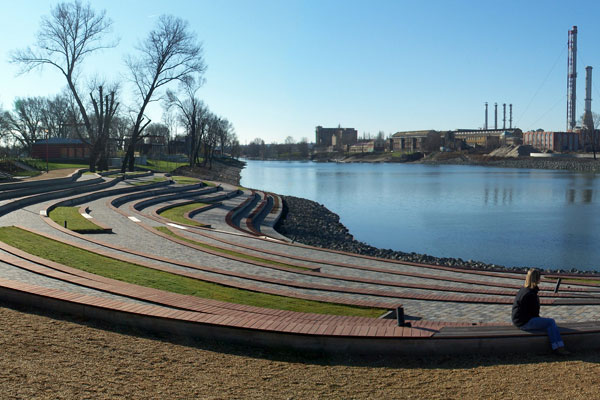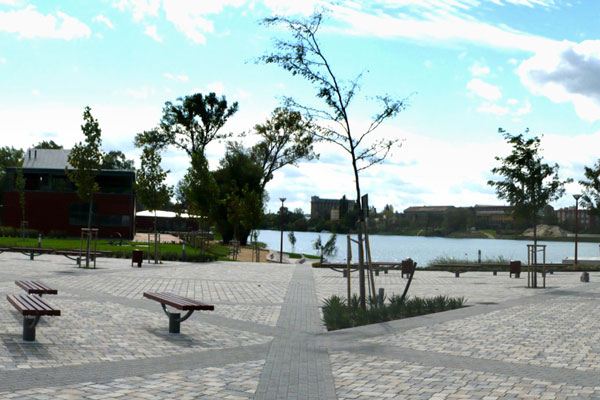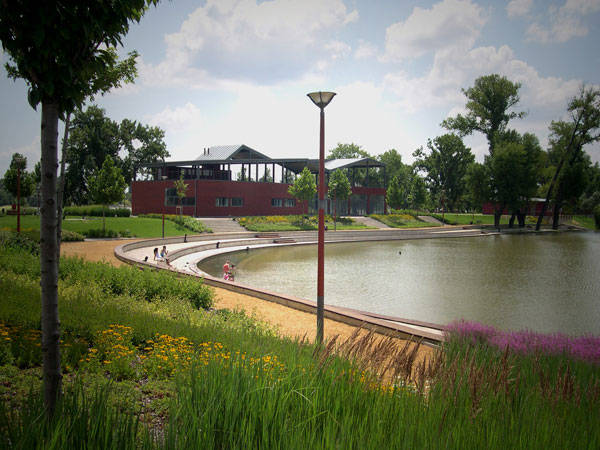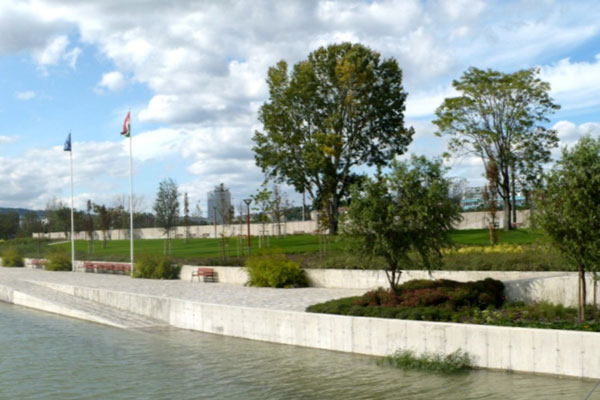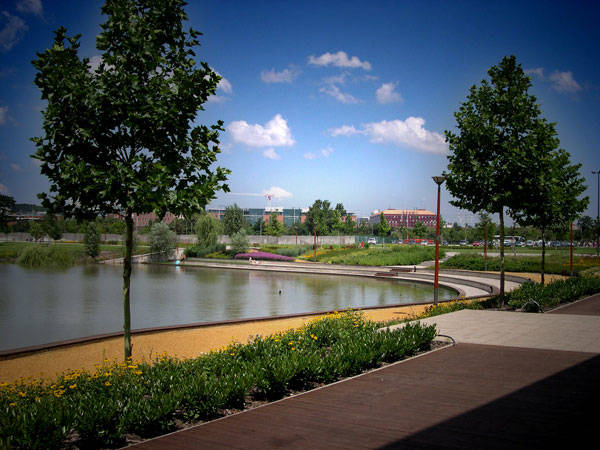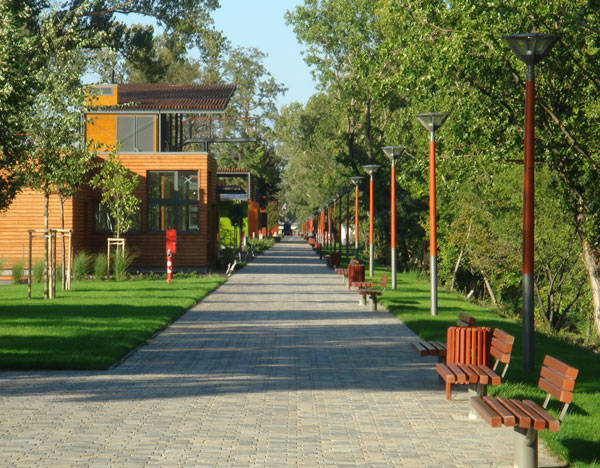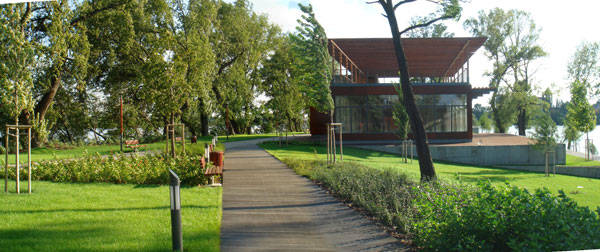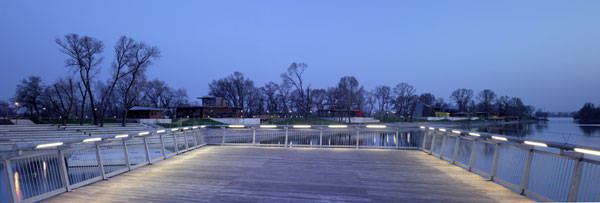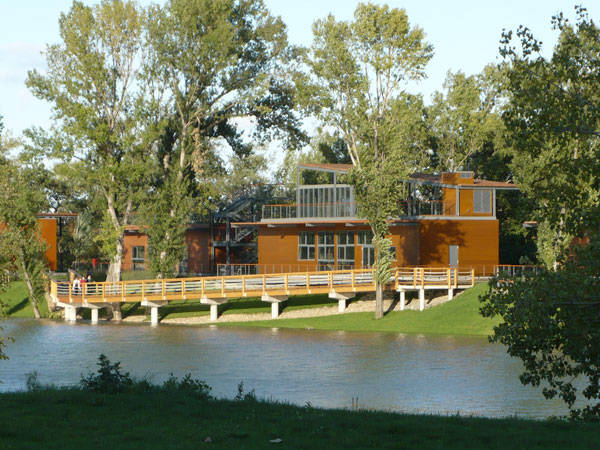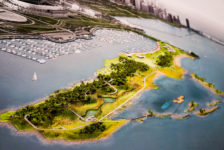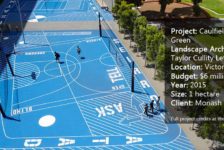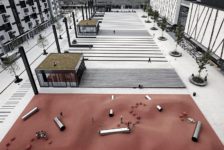Kopaszi Dam in Budapest, Hungary, by T2.a Architects and Garten Stúdió Ltd. Imagine a piece of land surrounded by water, near delicious restaurants and cool places to hang around, and offering the perfect touch of nature everywhere: How cool would that be? And if the reality is that this land was once abandoned, that fact definitely adds some special value.
In 2004, the owner of Kopaszi Dam in Budapest, Hungary, and the XI district municipality called for an open, national architectural competition to complement a large-scale real estate development in the area. As the winner, T2.a Architects led the design and construction, while Garten Studio Ltd. did the landscape design. The designers of Kopaszi Dam didn’t just “design” it and make it beautiful, they actually injected life into a dead piece of land, turning the never visited site into something “randomly visited”. The Birth of the Peninsula After the great flood of 1838, the area of Lágymányosi Bay began to transform. Gellért Hill is a historic hillside in Budapest. To its south, the shore that accommodates some of the city’s main transportation lines was built, giving birth to Lágymányosi from the Danube River. Around 1870, a dam was erected at the narrow peninsula and named “Kopaszi Dam”. It was partially used by the water police, and since the general public had no business there, the potentially beautiful land remained unseen.Waterfront Regeneration revitalizes a Lost World
The current owner of the site, property developer Öböl XI Ltd., actually handed over this lost world to Budapest’s people. When they acquired the land, it contained only some modest wooden barracks, which were being used as a home for the water police and some little restaurants. Due to lack of maintenance, it was a heavily polluted industrial site and the structures were in a very pathetic condition. The waterfront regeneration of Kopaszi Dam was completed in 2007 — and it made that summer totally different in Budapest. People suddenly had a new destination to go to to pass leisure time, to walk their dogs, to take the children to play, or to just have some delicious food in a unique restaurant.
Magnets That Pull People to this Waterfront Regeneration Park
It is easily understandable that it wasn’t an easy job to bring the site back to life. To begin with, it had been abandoned for a long period of time; thus, people had almost forgotten that it ever existed. The site is also pretty far from the city center. So to entice visitors, the designer had to create magnets that would pull people in and charm them enough to bring others. This kind of project that engages public interaction must be backed up with extensive study and observation of the city people’s lifestyle, taste, and preferences.
As a perfect example of this city’s need, we can look at Millenáris Park, which is situated in a former industrial site in Budapest. The child-friendly environment, pond and playground, green park, and venue for concerts and other performances have made it a vibrant public space. From that point of view, the Kopaszi Dam had more potential as a site, being situated in the most beautiful part of the city. What attracts visitors the most is the magnificent waterfront setting, with restaurants, cafes, playhouses, and terraces. It is perfect for relaxation, sports, romantic strolls, and family time. Related articles:- 20 Million Euro Investment in Urban Waterfront Regeneration Pays Off at the Ljubljanica Embankment in Slovenia
- 10 Awesome Riverbank Projects
- Industrial Site Transforms into Beautiful Landscape
Doing the Least to Do it All Kopaszi Dam is a narrow peninsula that is 1 kilometer long. During the first phase of the waterfront regeneration project, the designers made a unique decision: They erected 14 pavilions at the exact position where the former barracks were. The shapes and sizes of the pavilions represent the lightness of local structures. This was done to preserve the old, organic timber building typology characteristics of the locality. When you are roaming here, walking barefoot, lying under a tree, relaxing on the sandy shore with a refreshing glass of cool lemonade, you won’t feel like the place is new or forced. It’s like it has been here for decades; it has grown here like an aged tree whose root has gone deep into the culture.
Intelligent and Sensitive Landscape design The Garten Studio has done a tremendous job with Kopaszi Dam. All the outdoor areas are carefully landscaped and harmonized with the built forms. Various flood levels were carefully examined before determining the shape of the riverside. At the lower parts, the trees of “Gallery Forest” are used to maintain the site of natural riparian vegetation, as these parts periodically flood. The inner lawns are decorated with colorful lanes of lower shrubs, canopy trees for shading, bright perennial plants, different sedges, and reeds. The free, wild green that Kopaszi Dam possesses is mind blowing. Materials, Forms, and Structures In this project, playfulness is everywhere. The total development has such an ease that it gives a platform for spontaneous human interaction. The buildings are designed intentionally with an expression of lightness and timelessness. The steel frames are dressed with different kinds of wood paneling, timber facades, and other lightweight wall structures, such as colored plastic or resin components. The structural detailing, unique shapes, and funky colors of the pavilions invite people and nudge them to interact with nature at the same time. Not only has the site been revitalized and regenerated, the environmental rehabilitation is also been achieved on the bay. The heavily polluted water is now living and fresh. Being a bit far from the city center could have been a downfall, but fortunately it’s not. Instead, it gives a certain charm to the site. It’s a perfect place for people who like crowds but also who want to be alone. The colorful surroundings are like brightly colored mushrooms growing naturally after rain. Do you need a walk into a secret wild world? Visit Kopaszi Dam. Recommended Reading:- Urban Design by Alex Krieger
- Landscape Architecture Now! by Philip Jodidio
Article by Auditi Bridget Biswas Return to Homepage
Published in Blog


